Translated by Irene Klotz
For breed judges, Koermeister and breeders the evaluation of
the German Shepherd dog is a daily activity. For all others, it is
likely of interest to know how a dog – especially your own – is
evaluated.
Johann Mayer, Regional Breed Warden of the Bavaria-South
Regional Group has compiled some of the most important criteria
for your information.
It is the job of the breed warden and Koermeister and also of the breeders, to look at a dog exactly and to evaluate it. The problem of an external evaluation is that many details of the skeleton are concealed from view by muscles and covering skin layers. The muscles must be firm, dry and well developed.
Prerequisite for strong, long muscles with ample reach is an anatomically correct skeleton, strong bones which fit together harmonically and form the bone structure.
Size – The German Shepherd dog belongs to the medium-sized breeds. The ideal height at the withers is 63 to 64 cm for males, and 58 to 59 cm for females. The dog should be slightly elongated, that is, the body should be slightly longer than the height of the withers. The chest depth should be approximately 45% of the height at the withers, and the running bones should be approx. 55% of this height.
The head should correspond to the body size and sex of the dog. The forehead, seen from the front and the side, shows only slight curvature. The upper portion of the head consists of approximately 50% of the entire length of the head. The mouth is strong, the lips are firm, dry and close.. The German Shepherd dog has a scissors bite, the incisors close in scissors formation over one another. The full dentition consists of 42 teeth – 20 in the upper jaw and 22 in the lower jaw. Puppies only have 28 teeth – missing the first premolars and the molars.
The ears are medium size, broad at the base and set high; they form a point at the top and are cupped towards the front. The eyes are dark, almond-shaped, set somewhat at an angle and should not be protruding. The neck should be strong, “with well developed muscles and without loose skin at the throat. Seven cervical vertebrae form the bone foundation.
The Lines – what does that mean?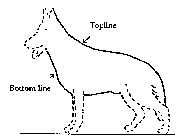
In the evaluation of our dogs we speak about lines, which should preferably be harmonic. The topline starts at the tip of the ears and continues on, without any sharp nick or interruption, over the back, gently falling to the tip of the tail. The bottom line begins at the neck and continues along the fore chest and lower chest and rises slightly towards the rear.
The important parts of the topline are:
The withers – should be high and very pronounced; when the dog is in a calm stand position, they form the highest point of the back. The back – must be straight, very well muscled and firm; it is formed by 13 vertebrae. The thighs should be broad and strong. There are 7 lumbar vertebrae which are firm-dry attached to each other. The croup should be long and slightly sloping at an angle of approximately 23 degrees. It consists of the sacrum, 3 coccygeal vertebrae, muscles and covering skin layers.
The bony portion of the tail, formed by 18 – 23 vertebrae, generally reaches the flocks and should not be longer than to the middle of the rear foot below the hock.
The important parts of the bottom line are:
The chest area, which provides necessary space for the inner organs, such as heart and lungs, and must therefore be well developed. The front and major part of the body is comprised of the chest, which is divided into the fore chest and lower chest.
The fore chest continues from the neck starting at the breastbone (sternum) to between the front legs. A well angled forequarter is indicated if the fore chest is easily visible from the side view.
The relationship of withers to body length is: 9 – 10, A dog with a height at the v6thers of 60 cm would therefore be 66 cm long.
“The chest depth should be less than half
the height at the withers; 46-47% of this height is the correct
measurement.”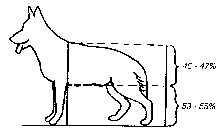
The lower chest line should be harmonic and rise only slightly towards the rear. The lower chest should be relatively long, in order to provide ample space for the inner organs. The chest depth consists of approximately 45% of the height at the withers. the ribs are slightly curved; there are nine true and four false pairs of ribs.
The shoulder blade is angled at approximately 45′ and lies flat against the withers, which are formed from the 11eUral spine of the first vertebrae.
Continuing on at an approximately 90′ angle is
the upper arm; the shoulder blade and
the upper arm, with a linking joint, form the shoulder. Continuing
on is the elbow joint and the forearm. The metatarsus joint
connects it to the pasterns at an angle of approximately 220.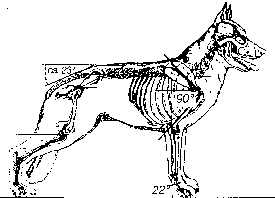
The elbow connection is often a problem area, especially in young dogs. Prerequisite for a good elbow connection is an appropriately wide chest area. If the chest is too wide (barrel chested), then the elbows are turned outwards and the dog tends to toe-in while walking and standing. If the chest area is too narrow (flat-ribbed, narrow-chested), then the elbows tend to be pressed in, and the dog tends to walk and stand with the feet in an “east - west” position.
The front is straight; the feet are round, short, tight, and curved. The nails are short, strong and dark in colour.
The rear quarter must be strong and well muscled. The thigh (femur) is connected, at its upper portion, to the hip joint, and at its lower portion, by the knee joint to the shank (lower leg).
The metatarsal bones are strong and connected over the hock to the shank. The dog should stand slightly set back.
Now that we have concentrated on the anatomical aspects of our dog’s structure, we will focus on the movement.
The German Shepherd dog is a “trotter”, he must be able to gait (trot) for long stretches with minimum effort. Prerequisite for this is the appropriate anatomical structure, combined with dry and strong muscles. The medium trot is the most natural type of movement of the German Shepherd. For a reaching stride, correct angulations are a requirement. Only with correct angulation of the rear quarter do the hind feet meet the steps of the front feet [under the dog] or even pass them. The trotter assumes an almost horizontal position while in motion. The forward movement initiated through the rear quarter is transferred to the forequarter over the croup and the back. Therefore, the length and position of the croup, as well as a short, firm back are of great importance for a good trotter.
Correct angulation of the rear quarter and broad, well muscled thighs enable the dog to have a powerful rear drive.
The forequarter has the responsibility to
complete the forward movement action and “catch” the
body. For the largest possible length of stride, the correct
angulation of the forequarter, with correct length and position of
the upper arm and shoulder blade are of importance.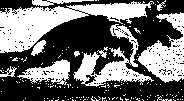
Anatomical faults influence the harmonic movement, e.g. faults in the back disrupt the line over which the energy of the forward motion is conveyed. A soft back acts like a bumper, the dog has no line and falls on the forequarter.
Limitations in angulation influence the length of the stride.
The other gaits of
the German Shepherd are the step, gallop and pace.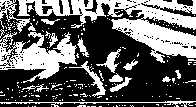
The step is the slowest gait; the dog always has three feet on the ground. He starts the motion in that he first moves the rear leg forward and then lifts and sets the front leg ahead.
The transition from a trot to a gallop is flowing. The gallop is the fastest gait, can however only be endured for a short period of time. The gallop is a type of Jumping gait, which is basically a quick succession of “broad jumps”.
The pace is the normal gait of giraffes and camels; for the German Shepherd, however, it is faulty. This gait involves moving the rear and front leg of the same side ahead in unison.
Also of importance for smooth flowing movement are the support lines. Support lines are imaginary lines which from a front view, flow vertically through bones and joints over the shoulder blade, upper arm, lower arm and pastern to the ground. From a rear view, the imaginary support line flows over the thigh, lower leg and hock to the ground. If these support lines are not straight, the elasticity [or “spring”] of the legs during the various forms of gaiting are unfavorably influenced. Straight bone structures are prerequisites for a secure stand and flawless movement of the dog. The German Shepherd should, therefore, have correct support lines, because only then will he be able to stand for long periods of time and to trot with endurance.
Verifying the anatomy is done at breed events. For this, the organization has introduced a schedule according to which the dog is judged and evaluated.
To begin with, the teeth, the tattoo in the right ear, and the testicles are checked.
Following this, the size, bone strength and structural proportions of height to length are evaluated.
In conclusion, the head, withers, back and croup as well as the angulations and chest proportions are evaluated; and from the front view, the correctness of the front.
Evaluating the gait involves evaluation of the stepping sequence from the back, from the front, and the trot.
For the evaluation of the trot, the length of the stride and the overall tightness are of importance.
A further glance takes in the ears and the tail carriage.
In the critique, the individual positive and negative features are to be assessed. The consideration of these individual features then becomes the overall evaluation, which results in the breed evaluation.
